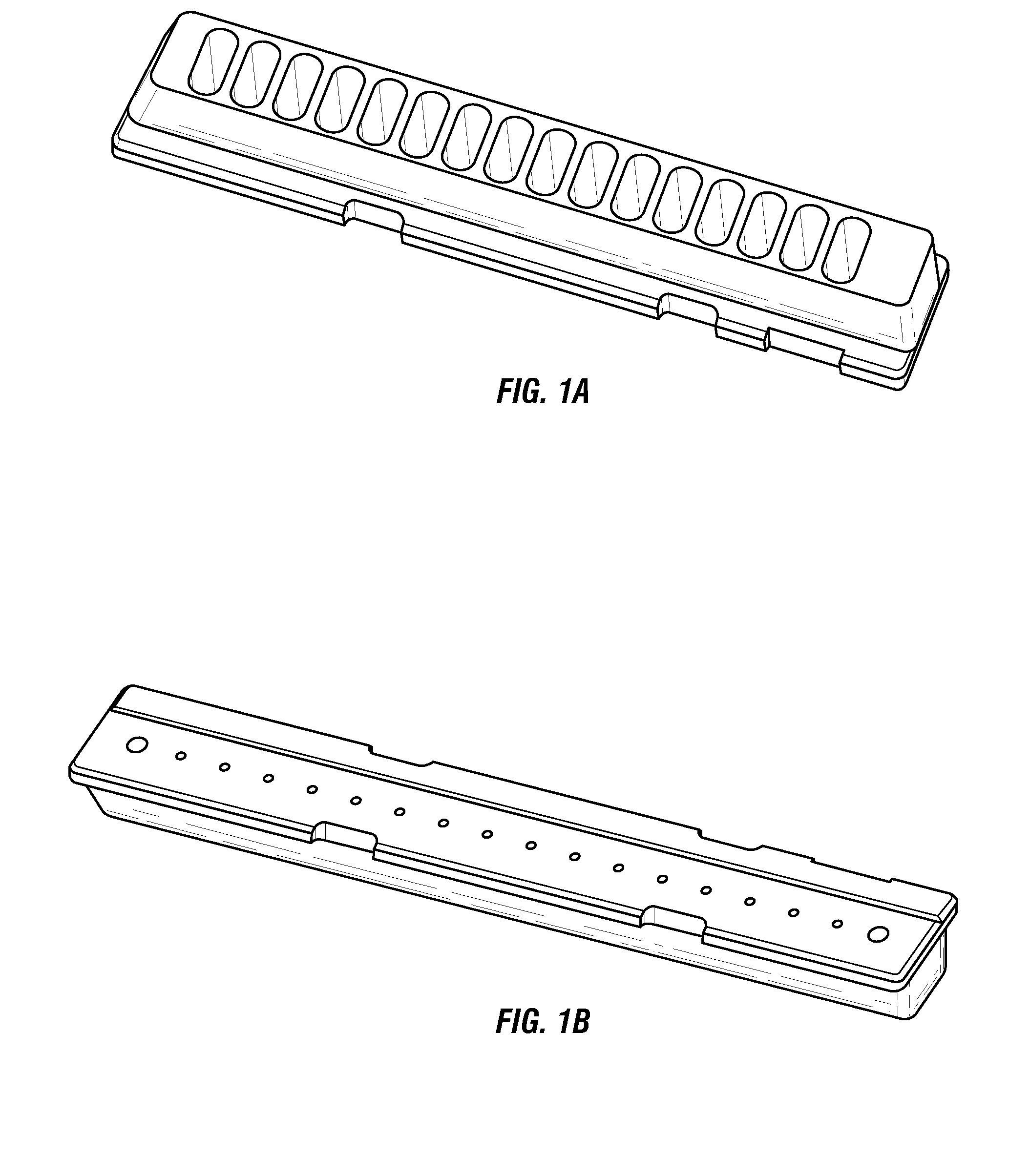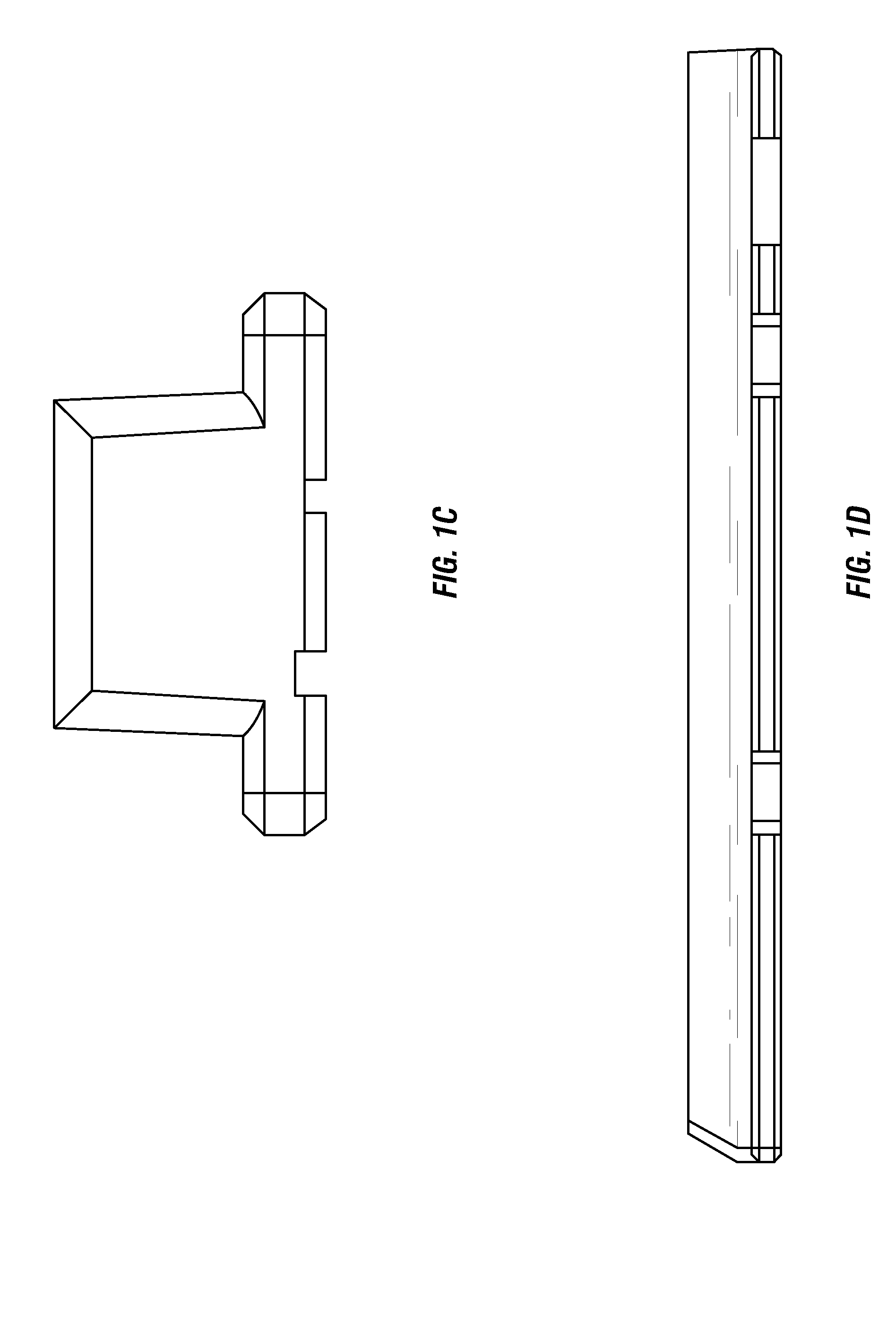High-density ion transport measurement biochip devices and methods
a biochip and high-density ion technology, applied in the field of high-density ion transport measurement biochip devices and methods, can solve the problems of high operator skill and time, met with little success, and the inability to automate the patch clamp method, so as to facilitate the measurement of the ion channel of the cell, enhance the sealing properties, and enhance the sealing properties
- Summary
- Abstract
- Description
- Claims
- Application Information
AI Technical Summary
Benefits of technology
Problems solved by technology
Method used
Image
Examples
example 1
Device for Ion Transport Measurement Comprising Upper Chamber Piece and Biochip
[0555]Upper chamber pieces with 16 wells having dimensions of 84.8 mm (long)×14 mm (wide)×7 mm (high) were injection molded with polycarbonate or NORYL® material. The distance between centers of two adjacent wells was 4.5 mm. The well wall was slanted by 16 degrees on one side and 23 degrees and contoured on the other side to allow guidance for cell delivery. The well holes had a diameter of 2 mm.
[0556]A biochip with 16 laser-drilled recording apertures had dimensions of 82 mm (long)×4.3 mm (wide)×155 microns (thick). The distance between the first hole and a narrow edge is 7.25 mm. The holes were laser drilled to have two counterbores of 100 microns (diameter)×100 microns (deep) and 25 microns (diameter)×35 microns (deep), respectively. A final through hole was drilled from the side of the counterbores and had a 7 to 9 micron entrance hole and a 2.0 micron exit hole with a total through hole depth of 20 ...
example 2
A 52-Chip Bench Mark Study
[0559]We have conducted a bench mark study using 52 single-hole biochips tested using a CHO cell line expressing the Kv1.1 potassium channel. The result demonstrated a 75% success rate as determined by the following criteria: 1) achievement of sealing of at least one gigaohm (a “gigaseal”) within five minutes of cell landing on a hole, and 2) maintenance of Ra of less than 15 MOhm, and Rm of greater than 200 MOhm throughout 15 minutes of whole cell access time.
Chip Fabrication
[0560]Patch clamp chips were designed at Aviva Biosciences and fabricated using a laser-based technology (without an on-line laser measurement device). The K-type chips were made from ˜150 micron thick cover glass. The ion transport measuring hole structures had ˜140 micron double counterbores and final through-holes of ˜16.5±2 micron depth. The apertures on the recording surface had a diameter of 1.8±0.5 microns. The recording surface was further smoothed (polished) by laser.
Surface T...
example 3
Treatment of Ion Transport Measurement Chips to Enhance their Electrical Sealing Properties
[0577]Detailed Procedure: (referenced to step numbers below). All incubation processes were carried out in self-made Teflon or Noryl fixtures assembled in a glass tank while shaking (80 rpm, with C24 Incubator Shaker, Edison, N.J., USA). Water was always as fresh as practical from a water purification system (NANOpure Infinity UV / UF with Organic free cartridge). Nitric acid was ACS grade (EM Sciences NX0407-2, 69-70%). Sodium hydroxide was 10 N, meeting APHA requirements (VWR VWR3247-7). When necessary, chips were inspected for QC before and after treatment.
The protocol used was:[0578]1. 3 hour shaking incubation in 6M nitric acid at 50 degrees C.[0579]2. 6×2 minute rinses in DI water at room temperature.[0580]3. 60 minute incubation in DI water (shaking)[0581]4. 2 hour shaking incubation in 5M NaOH at 33 degrees C.[0582]5. 6×2 minute rinses in DI water at room temperature.[0583]6. 30 minute i...
PUM
| Property | Measurement | Unit |
|---|---|---|
| size | aaaaa | aaaaa |
| volume | aaaaa | aaaaa |
| volume | aaaaa | aaaaa |
Abstract
Description
Claims
Application Information
 Login to View More
Login to View More - R&D
- Intellectual Property
- Life Sciences
- Materials
- Tech Scout
- Unparalleled Data Quality
- Higher Quality Content
- 60% Fewer Hallucinations
Browse by: Latest US Patents, China's latest patents, Technical Efficacy Thesaurus, Application Domain, Technology Topic, Popular Technical Reports.
© 2025 PatSnap. All rights reserved.Legal|Privacy policy|Modern Slavery Act Transparency Statement|Sitemap|About US| Contact US: help@patsnap.com



